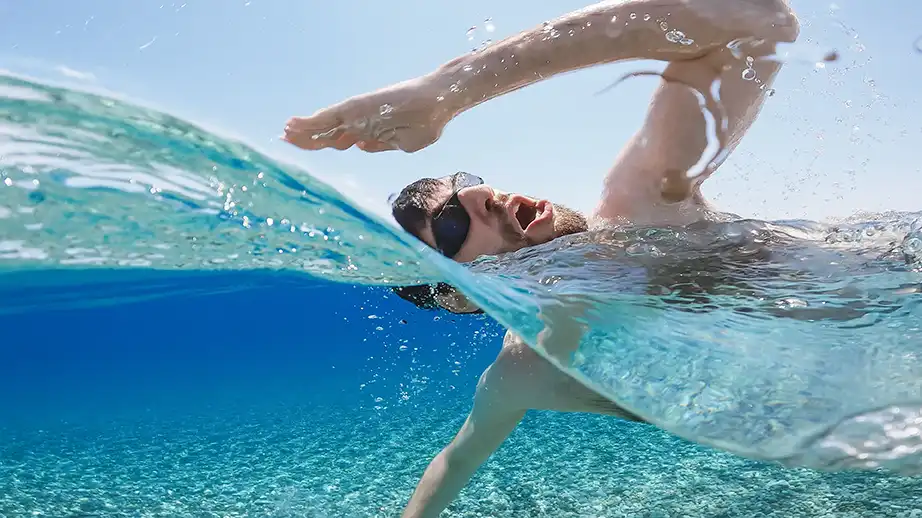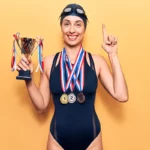How To Train Like An Olympic Swimmer: A Pro Training Schedule Guide

Did you know elite swimmers like Michael Phelps swim up to 13 kilometers a day, six or seven days a week as part of their professional swimmer training schedule?
Most competitive swimmers train 5-6 days weekly with sessions that last 1-2 hours. Olympic-level athletes take it further by practicing twice daily and spending 5-6 hours in the pool. Their training program requires swimming 12-14 kilometers daily. These athletes need to consume between 8,000-10,000 calories to support their intense workouts. Swimming stands out as one of the best full-body workouts and works multiple muscle groups including back, shoulders, triceps, biceps, abdominals, quads, hamstrings, chest, and calves.
Athletes who want to become skilled at competitive swimming need to understand how champions train. This piece breaks down elite swimmer training’s core elements. It covers daily session structure, strength training for swimmers, recovery protocols, and mental conditioning techniques that transform good swimmers into great ones.
Build a Swimmer’s Daily Training Schedule
Professional swimmers build their success on structured routines, consistency, and smart planning. These elite athletes live and breathe pool time. Their disciplined daily practice shapes them into champions.
Morning and evening swim sessions
Top swimmers usually train twice a day – early morning and late afternoon. They hit the pool between 5:00-6:00 AM for a two-hour session. After taking time to recover, eat and rest, they’re back in the water from 3:00-5:00 PM.
Morning workouts build stamina through distance sets and technique work. A typical session looks like this:
- A 15-20 minute dynamic warm-up on land
- 1,000-2,000 meters of swimming warm-up
- Main set to build endurance (2,000-4,000 meters)
- Technical drills to perfect strokes
Evening training packs more intensity with sprints, race-pace sets, and specialized event training. This two-session approach lets coaches target different energy systems throughout the day.
Balancing school, work, and training
Time management becomes the key for top swimmers who balance academics or careers with their pool time. These athletes must plan their day around training blocks efficiently.
These dedicated swimmers develop amazing organizational skills naturally. They study during lunch breaks or between sessions. Their class schedules fit around pool time, and they stick to regular bedtimes to get enough sleep. College swimmers often pick early morning classes to free up their afternoons for training and recovery.
Smart swimmers learn to turn down activities that clash with their training. This doesn’t mean giving up their social life completely. They just choose their commitments carefully and plan ahead. Many teams include group activities so athletes can stay connected without missing training.
Weekly training volume for elite swimmers
Training volume changes based on each swimmer’s specialty, training phase, and personal needs. In spite of that, elite swimmers put in serious distances weekly:
Distance specialists clock 60,000-80,000 meters across 9-10 sessions. Middle-distance athletes swim 50,000-60,000 meters in 8-9 sessions. Sprinters log 35,000-50,000 meters but focus more on quality and intensity than pure distance.
Olympic-level swimmers train 6-7 days a week during intense blocks. Smart scheduling matters – coaches add rest days and recovery weeks to prevent burnout. To cite an instance, see how training volume drops 50-70% during taper periods before big meets, while keeping some high-intensity work.
Elite programs plan their training around yearly, monthly, and weekly cycles. This approach helps swimmers peak during major competitions instead of burning out from non-stop heavy training.
The life-blood of swimming success isn’t just about swimming meters. Champions rarely skip practice. They know each session builds toward their long-term goals and creates physical changes that shape their performance when it counts.
Master the Core Elements of Swim Practice
Olympic swimmers’ performance comes from carefully designed practice sessions. These elite swimming sessions follow a scientific structure that helps athletes achieve peak physical condition and technical excellence.
Warm-up, pre-set, and main set structure
Professional swim practices follow a consistent pattern to streamline processes and prevent injury. Athletes typically cover 3-8 miles (approximately 5-13 kilometers) in a full practice session based on their training phase and specialty.
Elite sessions start with 5-15 minutes of dynamic stretches on land and continue with 10-20 minutes of swimming warm-up. This preparation gradually raises heart rate, boosts blood flow to muscles, and loosens joints. Athletes reduce their injury risk and perform better as a result.
Swimmers move to the pre-set after warming up. This crucial phase readies athletes for the main set’s focus. To cite an instance, when the main set focuses on backstroke, the pre-set includes backstroke elements that prepare the swimmer’s body properly.
The main set becomes the workout’s central focus and often runs over an hour. This crucial segment takes up one-third to two-thirds of the entire practice. It delivers the key physiological stimulus—whether you need to build lactate tolerance, perfect race pacing, or refine technique.
See Your Stroke, Improve Every Lap. Train like an Olympian with SwimMirror. Get real-time visual feedback and refine your technique every time you swim.
Technique drills and stroke refinement
Champions stand out because of their technical proficiency. Elite programs spend substantial practice time on stroke mechanics. They understand that proper technique lets swimmers move through water efficiently.
Good drills focus on specific parts of stroke technique. Sprint champion Nathan Adrian values single-arm freestyle with fins, paddles, and snorkel: “You can work on pretty much every aspect of your stroke in this way”. This drill helps swimmers by:
- Reinforcing proper body position and head alignment
- Maintaining steady leg movement
- Developing stroke awareness with adequate rest during slow execution
Swimmers can also benefit from closed-fist freestyle that boosts forearm awareness, finger-drag that promotes high-elbow recovery, and super-slow swimming that increases stroke awareness. These exercises break bad habits while building correct muscle memory and specific strength.
Sprint vs distance training sets
Sprint and distance swimmers train differently based on their events. A swimming coach notes that saying “It is sprint/distance day!” brings mixed reactions—some athletes celebrate while others anticipate the challenge ahead.
Sprint training focuses on explosive power, perfect technique, and anaerobic capacity. Sprint-focused athletes swim less but train at higher intensity. Their sets emphasize maximum speed with long rest intervals—usually 2-3 minutes between efforts to ensure peak power output. Sprinters learn that “no pace, only all-out speed” matters because a single second can cost them the race.
Distance swimmers concentrate on developing aerobic capacity and efficiency. Their training builds metabolic endurance and helps maintain technique under fatigue. These specialists perform sets that require consistent speed over long periods, sometimes swimming without breaks for 15-20 minutes. They learn to keep effective stroke mechanics while building the aerobic base needed for sustained performance.
Both types of swimmers learn from crossover training. Distance swimmers get better by adding short, maximum-effort sprints to build power and speed. Sprinters benefit from endurance work that improves their overall conditioning and recovery capacity.
Incorporate Strength and Dryland Workouts
Swimmers need strong foundations outside the pool to reach Olympic-level performance. Research shows that dryland training improves swimming sprint times by a lot and helps prevent injuries from repetitive strain.
Bodyweight vs weight training for swimmers
Many people think strength training requires expensive equipment. The reality is that bodyweight exercises give swimmers at all levels enough challenge. Basic movements like push-ups, pull-ups, lunges, and squats are the foundations of proper movement skills before adding weighted resistance.
Bodyweight training comes with great practical benefits. Athletes can do it anywhere with minimal equipment while developing better coordination and control. Young swimmers (ages 6-10) should become skilled at proper form with bodyweight exercises before they start using weights.
Weight training becomes more vital as swimmers get older. Research published in the Journal of Strength and Conditioning Research revealed that a 10-week resistance program improved explosive power more than swim training alone. Athletes who lift weights also build stronger bones—this is a vital benefit since swimmers’ bone structure is often weaker compared to other athletes.
Core and mobility exercises
A swimmer’s core guides all swimming movements. It helps transfer force between upper and lower body efficiently. Strong core muscles keep the body positioned well, cut down drag, and create power during starts and turns.
The best core exercises for swimmers include:
- Planks with shoulder taps to develop anti-rotation stability
- Hollow body holds that mimic streamline position
- Superman holds for posterior chain development
- Russian twists for rotational strength
Shoulder mobility work plays a key role in preventing injuries. A well-laid-out dryland shoulder routine reduces pain and injury risk among competitive swimmers. Wall angels and shoulder rotations help balance out swimming’s repetitive overhead motions.
How often to do dryland training
Elite swimmers usually do dryland training 2-3 times weekly. Some programs use 4-5 sessions with different intensities. Coaches recommend switching between high and low-intensity days and keeping 48 hours between tough sessions.
High-intensity dryland sessions build strength, power, and speed through resistance exercises and plyometrics. Low-intensity days focus on recovery and building aerobic base through continuous circuits or interval training.
Swimmers must balance dryland frequency with their pool time. Adding strength training means reducing swim training volume to handle the extra physical demands. This balanced approach helps athletes develop all-around fitness while staying fresh throughout their competitive careers.
Prioritize Recovery and Nutrition
Recovery is the missing link in many swimmers’ training programs. Olympic champions consider it just as important as their time in the pool. The body needs strategic recovery practices to adapt and get stronger after tough workouts.
Stretching and cooldown routines
Post-swim stretching makes recovery better by lengthening muscles and helping blood flow. Good stretching reduces muscle imbalances, helps prevent injuries, and lets you exercise more effectively. Note that you should stretch while your muscles are still warm—right after swimming.
A good cooldown starts with 400-meter easy swimming that helps remove lactic acid. Swimmers should then do static stretches and hold each position for 20-30 seconds without bouncing. These are the most important stretches:
- Pectoral stretches using doorways to fight forward-shoulder pull
- Ankle flexibility work to make kicks more powerful
- Shoulder mobility exercises to make streamlining easier
Sleep and its role in performance
Sleep is nature’s most powerful recovery tool. Elite athletes need 9-10 hours of sleep each night, while most people need 7-9 hours. Research shows that 71% of elite athletes get at least one hour less sleep than they should.
Studies show how sleep affects athletic performance in amazing ways. Stanford basketball players who slept 10 hours each night saw their sprint times and shooting accuracy improve by 9%. The same happened with swimmers who increased their sleep to 10 hours – they had faster reaction times off blocks and better kick strokes.
Fueling with the right foods and hydration
Swimmers lose a lot of fluid, so they need good hydration strategies. Sports drinks give you the sodium, chloride, and carbohydrates needed to replace electrolytes and feed your muscles during workouts longer than an hour. Summer training requires about 8 ounces (one cup) of fluid every 15-20 minutes.
Elite swimmers have huge appetites. Adam Peaty eats between 6,000-8,000 calories daily—triple what an average man eats—to keep his muscle mass during hard training. Michael Phelps became famous for eating 8,000-10,000 calories while swimming 13 kilometers each day.
Timing your recovery nutrition is vital. Your body recovers faster when you eat protein and carbohydrates within 30 minutes after practice. Professional swimmers take this seriously and drink protein shakes or eat fruits and Greek yogurt right after workouts. This helps refill glycogen stores and starts muscle repair quickly.
Train the Mind Like a Champion
Mental training sets champions apart from competitors in Olympic swimming. Physical preparation matters, but the mind often decides who wins when top athletes compete at elite levels.
Goal setting and visualization
Olympic swimmers plan their mental preparation through organized goal setting. Elite athletes break down their objectives into three types:
- Outcome goals: Securing medals, qualifying for teams, or breaking records
- Performance goals: Achieving specific times or technical measures
- Process goals: Daily steps that lead to bigger achievements
Well-planned goals affect athletes deeply and anchor their motivation when anxiety threatens their focus. Athletes who use the SMART principle (Specific, Measurable, Attainable, Realistic, Time-bound) show more determination and focus.
Visualization stands as the life-blood of mental excellence. Elite swimmers like Adam Peaty credit visualization that helps them perform under pressure: “I’d swum that race a thousand times in my head,” Peaty explains about his Olympic performance. The brain cannot distinguish between vivid mental images and real experiences. Research with weightlifters shows brain patterns match during both visualization and physical activity.
Building mental resilience
Athletes develop mental toughness through challenging situations. Coaches use “pressure inurement training” that gradually increases competitive stress during practice and prepares swimmers for high-stakes moments. This method helps normalize stress responses and builds psychological strength.
Olympic champions show resilience through three elements: personal qualities (grit, optimism), supportive environments (helpful coaches, constructive feedback), and a mindset that sees pressure as a chance rather than a threat.
Conclusion
Olympic swimmers’ training requires exceptional dedication in many ways. This piece explores the demanding schedules that turn talented swimmers into champions. These athletes dedicate themselves to two sessions daily and spend 5-6 hours in the water while swimming 12-14 kilometers each day. Physical training is just one part of their complete approach.
Success at the Olympic level depends on balancing several key components. Well-laid-out pool sessions with scientific warm-ups, targeted pre-sets, and challenging main sets build the physiological foundation needed to compete. Mutually beneficial dryland training develops the strength, power, and mobility without affecting swimming performance. Athletes must also pay close attention to recovery protocols—especially when it comes to sleep and nutrition—to maintain their intense training loads.
Mental conditioning makes the difference between true champions and talented swimmers. Athletes prepare themselves for high-stakes competition pressure through visualization, goal-setting, and stress management techniques. These swimmers train their minds just as precisely as they work on stroke mechanics.
The path to Olympic-caliber swimming needs substantial sacrifice. Athletes structure their lives around training blocks, watch their nutrition carefully, and put recovery ahead of regular activities. This complete approach might be tough but creates exceptional athletes who deliver remarkable performances.
Note that elite swimmers didn’t start with superhuman abilities—they developed them through smart, consistent training. You can see substantial improvements whatever your current level by using elements from professional training programs in your swimming. Start small, stay consistent and increase intensity as your body adapts. Your swimming potential waits to be discovered through dedicated practice and proper technique.
FAQs
Q1. How many hours do Olympic swimmers typically train each day?
Olympic swimmers usually train for 5-6 hours daily, split between two sessions. They often swim 12-14 kilometers per day, with morning and evening practices focusing on different aspects of their training.
Q2. What does a typical weekly training schedule look like for elite swimmers?
Elite swimmers generally train 6-7 days a week. Their schedule includes twice-daily swim sessions, dryland training 2-3 times weekly, and strategic rest days. The exact routine varies based on the swimmer’s specialization and current training phase.
Q3. How do competitive swimmers balance their training with other aspects of life?
Competitive swimmers carefully organize their days around training blocks. They often schedule classes or work commitments to accommodate their swim sessions, prioritize sleep, and learn to manage their time efficiently to maintain a balance between training, academics or career, and limited social activities.
Q4. What role does nutrition play in an Olympic swimmer’s training regimen?
Nutrition is crucial for Olympic swimmers. They typically consume between 6,000-10,000 calories daily to fuel their intense workouts. Proper hydration and timing of meals, especially post-workout nutrition, are essential for recovery and maintaining performance during heavy training periods.
Q5. How do Olympic swimmers prepare mentally for competitions?
Olympic swimmers use various mental training techniques to prepare for competitions. These include goal setting, visualization of races, pressure management strategies, and building mental resilience. Many work with sports psychologists to develop these skills and handle the psychological demands of high-stakes competitions.





Write a Reply or Comment